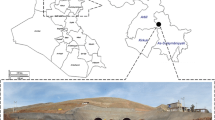Summary
The planned network for the Munich subway system has a total length of about 100 km with 106 stations. At present 46 km of subway and 50 stations are in operation. A further 17 km and 18 stations are under construction. The annual volume of construction work has reached a total of approximately 300 million DM.
A stretch of 21 km has been constructed using shotcrete support. A part of this work still has to be completed.
In the paper, the method of tunnelling using shotcrete is presented in its total context, whereby the important aspects are discussed under the following themes:
Overview of the construction project as a whole with reference to finance, permitting procedures and realisation. Cut-and-cover and mining techniques. The construction of single-track tunnel and the excavation of large cross-sections, switches and sidings, different geotechnical procedures in dealing with water, especially compressed air operations.
Experiences with contract practices, construction, questions of safety, quality and cost control, damage analysis and comparison of costs.
Similar content being viewed by others
References
Amstad, Ch., Kovári, K. (1984): Strain Monitoring in the Subsoil of the Munich Subway, Proc. of the 2nd Conference on Mass Transportation in Asia, Singapore.
Baumann, Th., Betzle, M. (1984): Investigation of the Performance of Lattice Girders in Tunnelling, Rock Mechanics and Rock Engineering, Vol. 17 No. 2
Gebhardt, P. (1977): Hydrologische Verhältnisse, geotechnische Probleme und praktische Erfahrungen bei den Wasserhaltungen des Münchner U-Bahn-Baues. Brunnenbau, Bau von Wasserleitungen, Rohrleitungsbau 10.
Hochmuth, W. (1979): München bleibt weiter auf U-Bahn-Kurs, Der stadtverkehr, H. 2, 1979.
Köppel, J., Amstad, Ch., Kovári, K. (1983): The Measurement of Displacement Vectors with the “TRIVEC” Borehole Probe, Proc. Int. Symp. on Field Measurements in Geomechanics, Balkema Publishers.
Kovári, K. Amstad, Ch., Arn, Th. (1982): Sicherheit und Wirtschaftlichkeit im U-Bahn-Bau München, Forschungsbericht (unpublished).
Krischke, A., Weber, J. (1981): Erfahrungen bei der Erstellung großer Tunnelquerschnitte in Teilvortrieben beim Münchner U-Bahn-Bau, Rock Mechanics, Suppl. 11.
Krischke, A. (1982): Wasserundurchlässiger Beton bei bergmännisch erstellten Tunneln der U-Bahn München. Auswertung einer zehnjährigen Erfahrung, Beton- und Stahlbetonbau, H. 9.
Lessmann, H. (ed.), (1978): Moderner Tunnelbau bei der Münchner U-Bahn, Springer Verlag, Wien — New York.
Lessmann, H., Gstir, J., Jelinek, M. (1986): Subway Tunnelling in Munich using Shotcrete with Compressed Air, Rock Mechanics and Rock Engineering, Vol. 2.
Soos, P. v. (1966): Baugrund und Gründungsprobleme in München, Baugrundtagung 1966, München.
Weber, J. (1979): Konstruktion, Auffahrfolgen und Meßergebnisse eng aneinanderliegender Tunnel beim Münchner U-Bahn-Bau, STUVA-Tagung, München.
Weber, J. (1983): Erfahrungen mit Druckluftvortrieben in Spritzbetonbauweise beim Münchner U-Bahn-Bau, Berichte der STUVA-Tagung in Nürnberg, Alba publishers GmbH, Düsseldorf.
Author information
Authors and Affiliations
Additional information
The work is based on 13 years of application and development.
Rights and permissions
About this article
Cite this article
Hochmuth, W., Krischke, A. & Weber, J. Subway construction in Munich, developments in tunnelling with shotcrete support. Rock Mech Rock Engng 20, 1–38 (1987). https://doi.org/10.1007/BF01019509
Issue Date:
DOI: https://doi.org/10.1007/BF01019509




